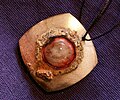Evil eye
Evil Eye
The Evil Eye is a belief system that is prevalent in various cultures worldwide. It is a superstition that the gaze or stare of a person can cause harm or misfortune to the person at whom it is directed. This belief is particularly strong in the Mediterranean and West Asia.
Origins[edit]
The belief in the Evil Eye dates back to ancient times and is found in many cultures around the world. It is mentioned in ancient Greek and Roman texts, as well as in many famous literary works, including the Bible and the Quran. The concept of the Evil Eye is also found in various forms in the folklore of many societies, including those of the Celts, the Native Americans, and the Hindus.
Beliefs and Practices[edit]
The Evil Eye is not just a passive act of cursing, but it is often a conscious, active intention of harm. The person who casts the Evil Eye is said to be envious or jealous and the harm that is caused by the gaze is often related to the area of life that the person is envious of. For example, if a person is envious of another's wealth, the Evil Eye might cause the victim to lose their wealth.
In many cultures, there are rituals and items that are used to protect against the Evil Eye. These can include amulets, charms, and rituals. The most common amulet is the Nazar, a blue eye-shaped charm that is used in Turkey and Greece.
Cultural Variations[edit]
The belief in the Evil Eye varies from culture to culture. In some cultures, the Evil Eye is seen as a powerful force of harm, while in others it is seen as a minor annoyance. The methods of protection against the Evil Eye also vary, with some cultures using amulets and charms, while others use rituals and prayers.
Scientific Perspective[edit]
From a scientific perspective, the Evil Eye is seen as a form of social and psychological phenomenon. It is a way for people to explain misfortune and harm that befalls them. It is also a way for people to express their fears and anxieties about the world around them.
See Also[edit]
References[edit]
<references />
Ad. Transform your life with W8MD's Budget GLP-1 injections from $75


W8MD offers a medical weight loss program to lose weight in Philadelphia. Our physician-supervised medical weight loss provides:
- Weight loss injections in NYC (generic and brand names):
- Zepbound / Mounjaro, Wegovy / Ozempic, Saxenda
- Most insurances accepted or discounted self-pay rates. We will obtain insurance prior authorizations if needed.
- Generic GLP1 weight loss injections from $75 for the starting dose.
- Also offer prescription weight loss medications including Phentermine, Qsymia, Diethylpropion, Contrave etc.
NYC weight loss doctor appointmentsNYC weight loss doctor appointments
Start your NYC weight loss journey today at our NYC medical weight loss and Philadelphia medical weight loss clinics.
- Call 718-946-5500 to lose weight in NYC or for medical weight loss in Philadelphia 215-676-2334.
- Tags:NYC medical weight loss, Philadelphia lose weight Zepbound NYC, Budget GLP1 weight loss injections, Wegovy Philadelphia, Wegovy NYC, Philadelphia medical weight loss, Brookly weight loss and Wegovy NYC
|
WikiMD's Wellness Encyclopedia |
| Let Food Be Thy Medicine Medicine Thy Food - Hippocrates |
Medical Disclaimer: WikiMD is not a substitute for professional medical advice. The information on WikiMD is provided as an information resource only, may be incorrect, outdated or misleading, and is not to be used or relied on for any diagnostic or treatment purposes. Please consult your health care provider before making any healthcare decisions or for guidance about a specific medical condition. WikiMD expressly disclaims responsibility, and shall have no liability, for any damages, loss, injury, or liability whatsoever suffered as a result of your reliance on the information contained in this site. By visiting this site you agree to the foregoing terms and conditions, which may from time to time be changed or supplemented by WikiMD. If you do not agree to the foregoing terms and conditions, you should not enter or use this site. See full disclaimer.
Credits:Most images are courtesy of Wikimedia commons, and templates, categories Wikipedia, licensed under CC BY SA or similar.
Translate this page: - East Asian
中文,
日本,
한국어,
South Asian
हिन्दी,
தமிழ்,
తెలుగు,
Urdu,
ಕನ್ನಡ,
Southeast Asian
Indonesian,
Vietnamese,
Thai,
မြန်မာဘာသာ,
বাংলা
European
español,
Deutsch,
français,
Greek,
português do Brasil,
polski,
română,
русский,
Nederlands,
norsk,
svenska,
suomi,
Italian
Middle Eastern & African
عربى,
Turkish,
Persian,
Hebrew,
Afrikaans,
isiZulu,
Kiswahili,
Other
Bulgarian,
Hungarian,
Czech,
Swedish,
മലയാളം,
मराठी,
ਪੰਜਾਬੀ,
ગુજરાતી,
Portuguese,
Ukrainian














